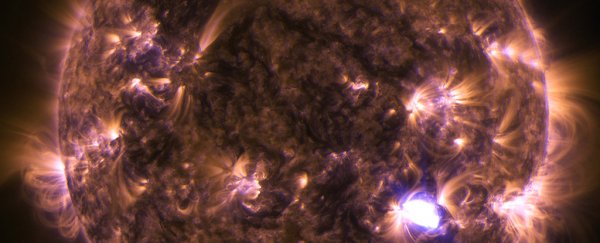Scientists have developed a new magnetic field hypothesis that helps to explain the way plasma fields snap and reconnect, and it could be an important step in making nuclear fusion viable.
Nuclear fusion has the potential to change our energy supply forever, because it could provide a clean, safe, and virtually limitless supply of it. But researchers have been struggling for decades make it work at the right scale. That's where this new plasma hypothesis could help.
Researchers from the US Department of Energy (DOE) and Princeton University have managed to explain the behaviour of plasma in the midst of a nuclear fusion reaction, which otherwise seems to defy the standard laws of physics.
The hypothesis looks at a mysterious phenomenon called magnetic reconnection, where magnetic field lines in plasma come together, break apart, and then explosively reconnect again. That's a big problem if you want to keep a nuclear fusion reaction stable.
The animation below gives you a representation of the phenomenon, with the fields shown as red and blue lines:
 ChamouJacoN/Wikimedia
ChamouJacoN/Wikimedia
As well as being present in nuclear fusion reactions, this magnetic reconnection causes solar flares, cosmic ray bursts, and the Northern Lights we see here on Earth.
But while scientists have previously developed an explanation for the phenomenon, they aren't sure why it happens so fast - much faster than conventional physics theory says it should.
The new hypothesis seeks to explain magnetic reconnection by referring to another phenomenon known as plasmoid instability, where plasma sheets are observed to break up into smaller islands when a strong electric current passes through them.
According to the team, plasmoid instability starts with a linear phase - which follows standard physics rules - then accelerates into a more explosive phase.
The researchers ran calculations to explain both the length of each phase and the physics underpinning each one, demonstrating for the first time how plasmoid instability could hypothetically lead to magnetic reconnection.
So, how does this affect nuclear fusion? Many of today's nuclear fusion experiments use powerful magnets to fuse hydrogen plasma into helium, but when the plasma starts creating magnetic fields of its own, the forces needed for a sustained reaction break down.
The new hypothesis could give us a better understanding of when magnetic reconnection will start to speed up, which in turn could help scientists figure out ways to contain or limit it, allowing for more stable, longer-lasting nuclear fusion reactions.
Right now, it's not certain that we'll ever manage to get nuclear fusion (or "star in a jar") reactions efficient and cheap enough to be of use, but scientists are hopeful.
There's an added bonus to the research, too, as it could help scientists predict when solar storms are likely to strike - the waves of energy from the Sun that have the potential to disrupt global communication and power networks.
But if one day we do find ourselves enjoying the benefits of nuclear fusion power, then we might have plasmoid instability to thank.
The research has been published in Physics of Plasmas.
